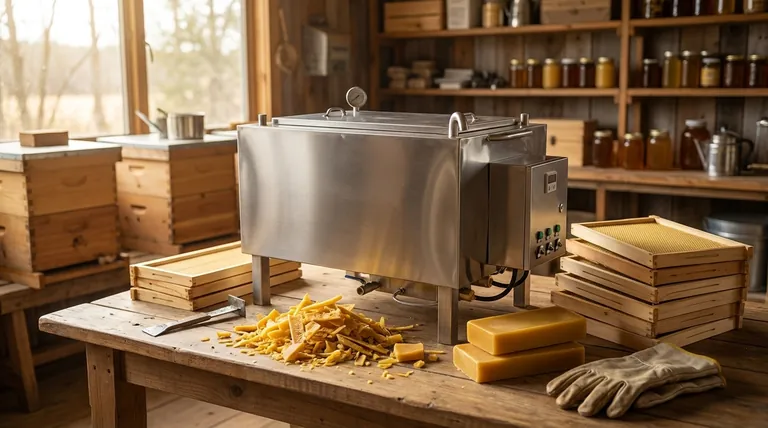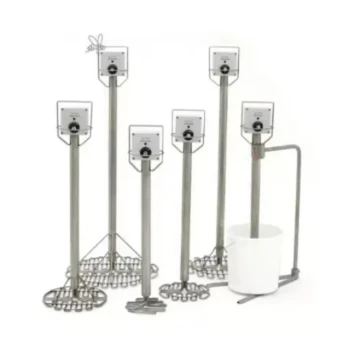In beekeeping, leftover scraps from cutting beeswax foundation should always be saved, washed, and re-melted. This practice honors the immense effort bees put into producing wax and ensures no part of this valuable resource is wasted. Treating scraps as a raw material rather than trash is a fundamental principle of sustainable and efficient apiary management.
Instead of viewing foundation scraps as waste, see them as a valuable raw material. Properly processing and reusing this beeswax promotes sustainability in your apiary, reduces costs, and allows you to create new, useful products.

The Value of Every Scrap: Why Beeswax is Gold
Understanding why you should save scraps is as important as knowing how. Beeswax is not a cheap, manufactured commodity; it is a precious biological product.
The Energy Cost of Wax Production
Bees must consume an estimated six to eight pounds of honey to produce just one pound of wax. This represents a massive investment of energy and foraging time for the colony. Discarding even small scraps is equivalent to throwing away the colony's hard work.
The Purity of Foundation Scraps
The wax used for foundation is typically high-quality and clean. This makes the scraps an excellent, pure starting material for rendering into new blocks or products, free from the debris and propolis often found in old comb cappings.
The Step-by-Step Process for Reclaiming Wax
Reclaiming wax is a straightforward process that requires attention to detail but not necessarily expensive equipment.
Step 1: Collection and Storage
Immediately collect all trimmings and leftover pieces after cutting your foundation.
Store these scraps in a sealed, airtight container. This is critical for preventing infestation from pests like wax moths, which can quickly destroy your supply.
Step 2: Washing and Cleaning
Before melting, it's good practice to wash your scraps. Place them in a bucket of cool or lukewarm water to rinse off any dust, debris, or honey residue.
Do not use hot water, as it will begin to melt the wax and create a mess. Once rinsed, strain the wax and let it air dry completely.
Step 3: Melting and Filtering
The safest way to melt wax is with a dedicated wax melter or a simple double boiler. Never melt wax directly over a flame, as it is flammable.
As the wax melts, it can be filtered through a layer of cheesecloth or a fine-mesh strainer to remove any remaining impurities. The result is clean, liquid beeswax ready for its next use.
Common Pitfalls to Avoid
While the process is simple, a few common mistakes can compromise your wax or create safety hazards.
The Risk of Disease Transmission
This is the most critical consideration. Never mix or reuse wax scraps from a hive that you know or suspect has a disease like American Foulbrood (AFB). The spores can survive the melting process and will contaminate any new equipment you make, spreading the disease.
Preventing Overheating
Overheating beeswax (above 185°F or 85°C) can darken its color and degrade its quality and aroma. Use a thermometer and gentle, indirect heat to preserve the wax's natural properties.
Protecting Stored Scraps from Pests
A forgotten bag of wax scraps is a prime target for wax moths. Ensure your storage container is truly sealed and kept in a cool, dry place. Some beekeepers freeze scraps for 48 hours to kill any existing eggs before long-term storage.
How to Use Your Reclaimed Wax
Once you have a block of clean, rendered wax, its uses are limited only by your imagination.
Making New Foundation Sheets
For beekeepers with a significant volume of scraps, investing in a foundation mold allows you to press your own sheets, creating a completely closed-loop system.
Casting Simple Wax Blocks
The most common and practical application is to pour the melted wax into molds (silicone baking pans work well) to create clean, solid blocks. These blocks are easy to store and can be sold or used for future projects.
Crafting Value-Added Products
Your reclaimed wax is a perfect, high-quality ingredient for other crafts. You can use it to make candles, lip balms, furniture polish, or waterproof canvas goods.
Making the Right Choice for Your Apiary
How you use your scraps ultimately depends on your goals and the scale of your operation.
- If your primary focus is simplicity and sustainability: Collect scraps throughout the year and melt them down into a single, clean block for easy storage and future use.
- If your primary focus is cost-savings at scale: Consider investing in a solar wax melter and foundation press to turn a steady supply of scraps into new foundation for your hives.
- If your primary focus is hobby crafting: View your reclaimed wax as a free, high-quality ingredient for making candles, balms, or other homemade products.
By treating every piece of wax as a resource, you align your practices with the efficient and sustainable nature of the honeybee colony itself.
Summary Table:
| Step | Key Action | Purpose |
|---|---|---|
| 1. Collection | Store scraps in a sealed container. | Prevent wax moth infestation. |
| 2. Washing | Rinse in cool water and air dry. | Remove dust, debris, and honey. |
| 3. Melting | Use a double boiler or wax melter. | Safely liquefy wax for filtering. |
| 4. Filtering | Strain through cheesecloth. | Remove impurities for clean wax. |
| 5. Using | Pour into molds for blocks or new foundation. | Create new products or supplies. |
Maximize the value of every scrap in your apiary. Properly reusing beeswax foundation trimmings is a core practice for sustainable, cost-effective beekeeping. At HONESTBEE, we supply commercial apiaries and beekeeping equipment distributors with the high-quality supplies needed to manage wax efficiently—from storage containers to solar wax melters. Let us help you build a more sustainable and profitable operation. Contact our wholesale experts today to discuss your equipment needs.
Visual Guide

Related Products
- Electric Commercial Beeswax Melter for Factory Use
- Solar Beeswax Melter Easy Solar Wax Melter for Beeswax
- Economy Manual Beeswax Embossing Mill Wax Foundation Machine Roller
- Electric Beeswax Foundation Machine With Operating Tray and Wax Foundation Roller
- Stainless Steel Jack Type Honey Comb Press Machine Wax and Honey Separator
People Also Ask
- What are the main advantages of the solar waxing machine? Harness the Sun for Pure, Cost-Free Beeswax
- How does a solar wax melter work? Harness the Sun to Reclaim Pure Beeswax
- How can beekeepers recycle combs from culled frames? A Guide to the Efficient Double Vat Method
- Can the Solar Wax Melter operate on partly cloudy days? Harness Solar Power Effectively
- How does the solar wax extraction method work? Reclaim Pure Beeswax with Sun Power



















